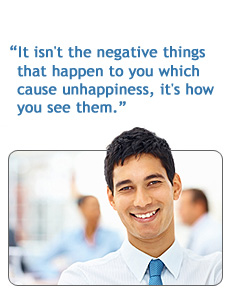 Is it Really Possible to Be Happy at Work -- No Matter What?Especially in tough economic times, it’s not unusual for everyone in a company – from the CEO to the receptionist at the front desk – to face extra worries over workplace issues as well as personal financial problems. However in his new book Happiness at Work: Be Resilient, Motivated, and Successful -- No Matter What (McGraw-Hill, 2010), business school professor Srikumar S. Rao, Ph.D., claims you can be happy on the job (and happy even if you are out of work and trying to find a new position) and succeed no matter what the circumstances are in your life.
Sound too good to be true? Dr. Rao, offers unique ways of looking at change and provides easy-to-do exercises in his book designed to shift your perspective about your job – for the better.
 Of course, for a lot of people the whole concept of finding “happiness at work” sounds like an oxymoron. There’s nothing about their job that makes them happy except picking up a paycheck. So can it really be possible even in a work situation where you just plain don't like what you are doing -- but can't quit due to your financial situation and the economic times -- to be truly happy at work?
“Yes it is!,” Dr. Rao tells Synergy. “The funny thing is that when you succeed in this (becoming happy), you will no longer be in that horrible environment. Somehow or other the universe will move to put you in more appropriate circumstances and sometimes in strange ways. For example, one student was in a really toxic hedge fund environment when he determined that he would not let himself be dragged down by the surrounding ethos. He was fired shortly afterward and immediately snapped up by a client of the fund who appreciated his upbeat attitude.”
Forget the affirmations and “thinking positive”If that anecdote has you suspecting Happiness at Work is another “just think positive” tome, think again. Taking a stand that may shock many people, Dr. Rao says affirmations and relying on positive thinking are not the key to creating a happy career, or a happy personal life. “Thinking positive thoughts will not create happy outcomes unless there is an accompanying shift in the mental models that a person holds that lead him or her to a dark view of life. Also, mere thinking without appropriate action is likely to lead to despair when the expected result does not transpire,” Dr. Rao explains.
Change your prismIn his new book, Dr. Rao discusses techniques that involve a conscious decision to choose what he calls “the prism” through which we view life. Bottom line: he demonstrates that it isn't the negative things that happen to you which cause unhappiness, it's how you see them. The key is to resist labeling situations as "bad," but rather try seeing them as neutral.
 “When you don't stick a ‘bad thing’ label on something that happens to you, then you don't experience it as bad. This does open you up to all kinds of possibilities,” Dr. Rao tells Synergy. “Gratitude is the most important attitude to cultivate,” he adds. “Most of the time we expend emotional energy on the stuff that we think is ‘wrong’ with our lives. Instead, flip this around and acknowledge the tremendous amount that is good in our lives.”
Shift your mental modelDr. Rao says we all have multiple “mental models” of how the world works. For example, your mental model may rigidly insist it’s necessary to come in to your office extra early and stay late in order to get a promotion. At some level, your mental models are true and at another level they are false. Confused? Dr. Rao explains that mental models are not reality -- they are what you think your reality is. Extra hours might help you get ahead but, then again, they might not if someone more qualified or who seems a better fit for the position you want comes along.
A better approach to mental models is to take yourself through an evaluation exercise, described in Happiness at Work, which helps you assess whether a mental model is working for you. If it’s not, maybe you need to test another way of approaching your job and life.
Dr. Rao points to a real-life example of a professor whose mental model had him frustrated because his students seemed to be unintelligent or not working hard enough. “Instead he decided that it was his job to excite students with the beauty of what he knew and wanted to share and so he kept trying to come up with better ways of igniting this excitement,” Dr. Rao says. “Not only did he start greatly enjoying teaching, he also won ‘best professor’ awards several times in a row.”
|